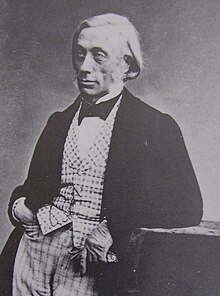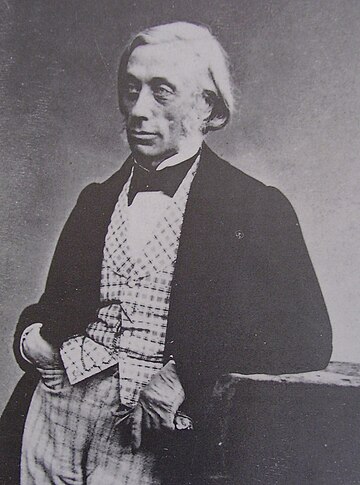讓-加斯帕爾-菲利克斯·拉謝·拉維松-莫利安(法語:Jean-Gaspard-Félix Laché Ravaisson-Mollien,法語:[ʁavɛsɔ̃ mɔljɛ̃];1813年10月23日—1900年5月18日),法國哲學家。後人評價他「或許是19世紀下半葉法國最有影響力的哲學家」。[1] 他的原名是菲利克斯·拉維松,這也是他最廣為人知的名字。[2]
他的「開創性的」「關鍵」著作是《論習慣》(De l』habitude,1838),英譯本題為Of Habit。[3][4][5]拉維松的哲學屬於法國屬靈主義[6]傳統,該傳統始於曼恩·德·比朗(1766-1824)的文章《習慣對思想能力的影響》(The Influence of Habit on the Faculty of Thinking, 1802)。不過,拉維松把他的學說發展成了他所謂的「屬靈主義的現實主義」(spiritualist realism)以及「屬靈主義的實證主義」(spiritualist positivism)。
根據研究拉維松的學者馬克·辛克萊(Mark Sinclair)的說法,可以認為,拉維松創立了「偶然性學派」。[7]
拉維松學說最著名、影響力最大的繼承者是亨利·柏格森,後者可以說是將此哲學傳統延續到了20世紀30年代,[8]儘管也可以認為「人生哲學」的這宗「血脈」於20世紀後期在吉爾·德勒茲那裏有所回歸。[9] 拉維鬆快三十歲時拒絕了雷恩大學的職位,此後也不曾在法國國立大學系統工作。[10] 在1838年,他受僱擔任公共建設部的首席私人秘書,而後穩步走上高位,比如圖書館監察長,然後在羅浮宮當古典文物策展人。[11]
晚年獲任法國哲學界評委會主席,這是個「相當有影響力的職位」。[12]
拉維松不僅是哲學家、古典學家、檔案家和教育管理家,而且也是畫家,以「拉謝」之名出展。
哲學工作
在哲學上,他是維克多·庫贊(Victor Cousin)的學派中的一員,在許多重要問題上都與他有過爭論。在他看來,意識行為是所有知識的基礎。意識的行動是意志的表現,而意志是智力生活的動力和創造力。上帝的理念是心靈的各種能力(faculties)在其對自然之中以及人之中的和諧的觀察中所給出的累積起來的直覺。在19世紀後期,這種理論對法國的思辨哲學相當有影響。
著作
拉維松「完整的」「三大」哲學著作是:
- 《關於亞里士多德形而上學的隨筆》Essai sur la métaphysique d'Aristote 兩卷(1837 年和1846年);
- 《論習慣》(DE L'habitude,On Habit,1838);
- 《關於19世紀法國哲學的報告》(Rapport sur la philosophie en France au XIXeme siècle,1867)。 [13] [14]
此外,拉維松還有許多「值得注意的文章」,例如
- 《當代哲學》(「La Philosophie contemporaine」,「Contemporary Philosophy」,1840 年);
- 《帕斯卡爾的哲學》(「La Philosophie de Pascale」,「Pascal's Philosophy」,1887 年);
- 《形而上學與道德》(「Métaphysique et Morale」,「Metaphysics and Morals」,1893 年)。 [15]
他去世後,還「留下了一部重要遺作的片斷,死後得以出版」,先是以《哲學遺囑》(「Testament philosophique」)為題發表於《形而上學與道德評論》(Revue de métaphysique et de morale,「Philosophical Testament」,1901年),後來以擴充過的形式出版為《哲學遺囑》(Testament philosophique,Philosophical Testament,1933 年)。 [15] [16]
| 年份 | 標題 | 初版詳情 | 英文標題 | 英文版出版詳情 |
|---|---|---|---|---|
| 1834 | De la Métaphysique d』Aristote | Unpublished competition manuscript.[a] Selections in De la nature à l』esprit, 2001.[b] |
||
| 1837 | Essai sur la Métaphysique d』Aristote [Vol. 1][c] | Paris: Imprimerie Royale, 1837.[d] | ||
| 1838 | De l』habitude | Sorbonne doctoral thesis (primary).[e] Paris: H. Fournier, 1838.[f] |
Of Habit | (1) Trans. C Carlisle & M Sinclair:[g] Of Habit, London & New York: Continuum, 2008.[h] (2) Updated trans. M Sinclair: Félix Ravaisson: Selected Essays, 2016, pp. 31–58.[i] |
| 1838 | Speusippi de Primis Rerum Principiis Placita Qualia Fuisse Videantur ex Aristotele | Sorbonne doctoral thesis (secondary) [In Latin].[j] Translated into French in 2012.[k] |
||
| 1840 | "La Philosophie contemporaine: Fragments de philosophie par M. Hamilton" | in La Revue des deux mondes, 1840, pp.397–427. | "Contemporary Philosophy" | Trans. J Dunham: Félix Ravaisson: Selected Essays, 2016, pp. 59–84.[l] |
| 1845 | Essai sur la Métaphysique d』Aristote [Vol. 2][m] | Paris: Joubert, 1845. | ||
| 1854 | De l』enseignement du dessin dans les lycées[n] | Paris: Dupont, 1854. | "The Art of Drawing According to Leonardo da Vinci" [Part trans.][o] |
Trans. M Sinclair: Félix Ravaisson: Selected Essays, 2016, pp. 145–58 |
| 1856 | "Mémoire sur le Stoïcisme"[p] | in Mémoires de l'Institut Impériale de France, Académie des Insciptions et Belle-Lettres, vol. XXI, 1857, pp. 1-94. | "Essay on Stoicism" | Trans. A Efal and M Sinclair: Félix Ravaisson: Selected Essays, 2016, pp. 85-144. |
| 1867 | La Philosophie en France au XIXème siècle[q] | Paris: Hachette, 1867. | ||
| 1871 | Venus de Milo [Version 1][r] | Paris: Hachette, 1871.[s] | ||
| 1875 | Les classiques de l'art: modèles pour l'enseignemnet du dessin | Paris: Rapilly, 1875[t] | ||
| 1880 | "Les monuments funéraires des Grecs"[u] | in Revue politique et littéraire. Revue blue, 10 April 1880, vol. XVIII, pp. 963-70. | "Greek Funerary Monuments" | Trans. M Sinclair: Félix Ravaisson: Selected Essays, 2016, pp. 229-242. |
| 1882 | "L'enseignement du dessin d'après M. F. Ravaisson" | in Dictionnaire de pedagogie et d'instruction primaire Vol. 1, 1882; Paris: Hachette, pp. 671-84.[v] | "On the Teaching of Drawing"[w] | Trans. T Viola and M Sinclair: Félix Ravaisson: Selected Essays, 2016, pp. 159-188. |
| 1887 | "La Philosophie de Pascale" | in La Revue des deux mondes 80, 1887, pp. 399–428. | "Pascal’s Philosophy"[x] | Trans. M Sinclair: Félix Ravaisson: Selected Essays, 2016, pp. 253–78. |
| 1892 | "Les mystères. Fragment d'une étude sur l'histoire des religions" | in Revue politique et littéraire. Revue blue, 19 March 1892, pp. 362-6. | "Mysteries: Fragment of a Study of the History of Religion"[y] | Trans. M Sinclair: Félix Ravaisson: Selected Essays, 2016, pp. 243-252. |
| 1892 | La Venus de Milo [Version 2][z] | in Mémoires de l'Académie des Insciptions et Belle-Lettres, vol. XXXIV, Part 1, 1892, pp. 145-256. also as off-prints by Klincksieck: Paris, 1892. |
"Venus de Milo" [Part trans.][aa] |
Trans. M Sinclair: Félix Ravaisson: Selected Essays, 2016, pp. 189-228. |
| 1893 | "Métaphysique et morale" | in Revue de métaphysique et morale 1, 1893, 6–25.[bb] | "Metaphysics and Morals" | Trans. M Sinclair: Félix Ravaisson: Selected Essays, 2016, pp. 279–94. |
| 1901 | "Testament philosophique" [Original][cc] | Ed. Xavier Léon in Revue de métaphysique et de morale 9/1, 1901, pp. 1–31. | ||
| 1933 | Testament philosophique [Expanded][cc] | Ed. Charles Devivaise. Paris: Boivin, 1933. | "Philosophical Testament" | Trans. J Dunham and M Sinclair: Félix Ravaisson: Selected Essays, 2016, pp. 295–336. |
Notes
| ||||
參考文獻
Wikiwand in your browser!
Seamless Wikipedia browsing. On steroids.
Every time you click a link to Wikipedia, Wiktionary or Wikiquote in your browser's search results, it will show the modern Wikiwand interface.
Wikiwand extension is a five stars, simple, with minimum permission required to keep your browsing private, safe and transparent.

